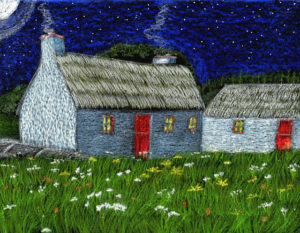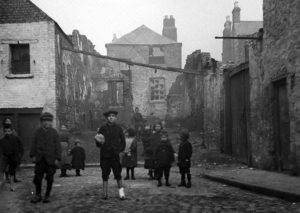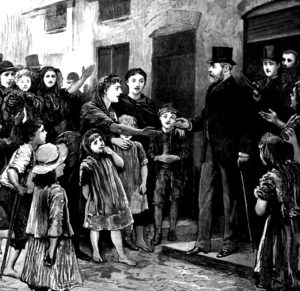Both Yeats’s Cathleen Ni Houlihan and Sean O’Casey’s The Plough and The Stars open with domestic scenes which hint at both plays’ agenda. Co-founder of the Gaelic League and president National Literary Society Douglas Hyde initiated the ‘stranger in the country kitchen’ motif with his play The Twisting of the Rope in 1901.[1] This motif uses the “cottage on stage” as a “temple of Irish domesticity, the sacred origin, the mystery of mysteries – within it the Irish are themselves.”[2] In contrast to the tradition of melodrama, Literary Revival plays sought to present the ‘real’ Irish as opposed to demeaning stereotypes. They succeeded, however, only in constructing an undifferentiated peasantry. Despite the diversity in portrayals, all these authors contributed to the process of “turning the peasants into a single figure of literary art…the ‘aestheticizing’ of the Irish country people.”[3] One generalization has been replaced by another.
Yeats and Lady Gregory use the peasantry to define the true spirit of the nation. When called by Cathleen, a thinly veiled representation of the nation, Ireland’s young men put aside selfish temporal interests to fight and die for her. The volk are united by a spiritual connection which drives them to self-sacrifice. This mythologizing of the peasantry reflected Yeats’s own struggle to develop a uniquely Irish literary style: “What distinguished Irish from English writers was a complex national identity, and in searching for that identity Irish writers turned, as if naturally, to the people they imagined to be most distinctively and authentically Irish: the peasants.”[4] This Anglo-Irish Ascendancy depiction of the peasantry as a primitive, spiritual people blankets over social, economic, and religious differences. It also expresses many of his individual beliefs. The peasants counter urban bourgeois commercialism. Yet Yeats was not alone in using the peasantry as a vehicle for his own ideology: “To speak about the peasant was always to speak about something beyond actual rural life.”[5]
Yeats and Gregory launched an ambitious ideological program that both tapped into a collective memory of the peasantry and targeted a narrower, more sophisticated audience than the melodramas. The Irish National Literary Theatre “aimed at being ‘literary’ in the tradition of the new art theatres of the 1890s, with their dreamlike, understated symbolism, their denial of spectacular productions and their preference for small audiences of refined cognoscenti; and…at being ‘national’ in the sense that it hoped to lift Irish culture out of second-rate drab provincialism and to let Ireland, in terms of threatre and literature at least, take its place among the nations of Europe.”[6] Using a cliché like the peasantry demonstrates the pervasiveness of the collective memory. It also helped the Ascendancy, the main patrons of Literary Revival theater, to assert their place within the nation. In his discussion of historical phases of collective memory, Pierre Nora claims that elites dominated the construction of national historical memory in the nineteenth century. Why was there a statue of Lord Nelson in the middle of Dublin? The Ascendancy identified as British and erected a monument recalling the glory of the Empire. By adopting a familiar popular cliché, however, Ascendancy figures redefine their identity as Irish.
O’Casey challenges the received characterization of the volk. His plays transplant the peasantry into an urban setting. Declan Kiberd criticizes his Dublin Trilogy for turning the inner-city poor into “jabbering leprechauns” in order to appeal to middle-class audiences.[7] Several characters, notably Fluther Good, from The Plough and The Stars even come close to the Stage Irish tradition. While this subversive work lacks the propagandistic intent of Cathleen Ni Houlihan, it employs the same clichés to make a different political point. Revolutionary nationalism failed to resonate with the majority of the people. Patrick Pearse’s rhetoric gets drowned out in a crowded bar. And the Easter Uprising becomes an excuse to loot fashionable stores. While O’Casey may have come closer to depicting the historical Dublin of 1916, his play aroused controversy by taking a familiar dramatic subject, the people, and challenging its common characterization in the melodramas and Yeats. No longer were the patriotic volk standing shoulder-to-shoulder ready to meet the nation’s enemies. O’Casey’s Dubliners refuse to get out of bed ‘at the rising of the moon.’ “Most groups settle temporarily on such collective memories and reproduce them for years and decades until they are questioned and perhaps overturned, often in the wake of generational turn-over. These repetitive representations form the backbone of collective memories.”[8]
Identity and Political Melodramas
Reception and the Literary Revival
[1] James Pethica, “Lady Gregory’s Abbey Theatre drama: Ireland real and ideal,” in The Cambridge Companion to Twentieth-Century Irish Drama, ed. Shaun Richards (New York: Cambridge University Press, 2004), 64.
[2] Joep Leerssen, “The theatre of William Butler Yeats,” in The Cambridge Companion to Twentieth-Century Irish Drama, ed. Shaun Richards (New York: Cambridge University Press, 2004), 44.
[3] Edward Hirsch, “The Imaginary Irish Peasant,” PMLA 106, no. 5 (Oct. 1991), 1117.
[4] Hirsch, 1121.
[5] Hirsch, 1118.
[6] Leerssen, 51.
[7] Cambridge Stephen Watt, “Late nineteenth-century Irish Theatre: before the Abbey – and beyond,” in The Cambridge Companion to Twentieth-Century Irish Drama, ed. Shaun Richards (New York: Cambridge University Press, 2004), 29.
[8] Wulf Kansteiner, “Finding Meaning in Memory: A Methodological Critique of Collective Memory Studies,” Theory and History 41, no. 2 (May 2002): 190.



